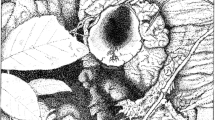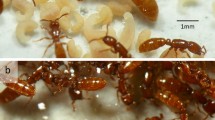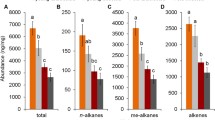Summary.
Army ants, although known as fierce predators, are rarely reported to prey on other army ants and most observed interspecific contacts were resolved comparatively peacefully. Of the four Asian Dorylinae, Dorylus (Dichthadia) laevigatus was believed to be the only species occurring on Borneo, sharing its habitat only with Aenictus and Leptogenys army ants and mass raiding Pheidologeton species. Using palm oil baits, we monitored the hypogaeic movements of D. laevigatus in Sabah (Malaysia, Borneo) and found a second species, i.e. D. cf. vishnui, also recruiting to the baits.¶To characterize the new species and differentiate it from D. laevigatus, we compared nine morphological traits. Hind tibia length, petiole shape, and number of antennal segments showed to differ significantly. Both species foraged predominately hypogaeicly and were found in similar habitats and altitudes. However, differences were found in bait utilization and foraging strategy. Furthermore, D. cf. vishnui seemed more likely to come to the soil surface than D. laevigatus. A phylogenetic analysis based on 385 basepairs of mtDNA confirmed the distinctiveness of both species. Interestingly, D. laevigatus showed considerable intraspecific differences between subpopulations from Java, West Malaysia, and even within Borneo, which might indicate that D. laevigatus is a species complex containing multiple cryptic species. A single male, collected from a light trap in Sabah, could be assigned to D. laevigatus using the same phylogeny, confirming this previously only assumed association.¶Encounters between the two species were observed at 11 baits, leading in ten cases to fierce fights. We provide the first detailed description of such interspecific fights, in which major workers were the fighters in both species. Experiments with intra- and interspecific mixing of workers in the laboratory showed D. laevigatus to have a higher aggressive level towards D. cf. vishnui than towards foreign conspecific colonies. No intraspecific fights between neighboring D. laevigatus colonies were observed in the field.
Similar content being viewed by others
Author information
Authors and Affiliations
Additional information
Received 22 July 2002; revised 7 November 2002; accepted 19 December 2002.
Rights and permissions
About this article
Cite this article
Berghoff, S., Gadau, J., Winter, T. et al. Sociobiology of hypogaeic army ants: characterization of two sympatric Dorylus species on Borneo and their colony conflicts. Insectes soc. 50, 139–147 (2003). https://doi.org/10.1007/s00040-003-0642-z
Issue Date:
DOI: https://doi.org/10.1007/s00040-003-0642-z




